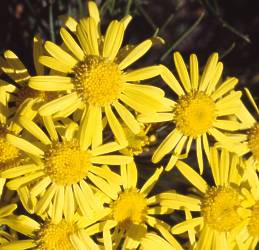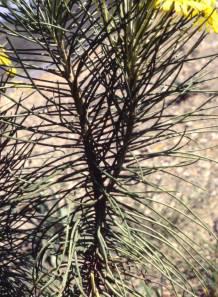Euryops tenuissimus
Euryops tenuissimus (L.) DC.
Family: Asteraceae
Common names: resin bush (Eng.); harpuisbos; grootharpuisbos; kortbeenharbuisbossie (subsp. trifurcatus) (Afr.)
Introduction
Travellers in large areas of the Western and Northern Cape will often stop during springtime to admire the stunning bright yellow flowering bushes along the roadside. Photographers, on the other hand, will immediately grab their cameras to preserve the beautiful image of these plants in their natural habitat forever.

Description
Description
Shrubs are perennial, up to 2.5 m high, well-branched, with the lower parts bare and upper parts of branches densely leafy. Leaves are 15-150 mm long, erect or spreading when young, reflexed when old, needle-like and sometimes divided in the upper part. Individual flower heads are borne on wiry stalks, 20-150 mm long and are clustered in the upper part of the flowering branches. Heads are 10-12 mm in diameter. The 8-24 ray florets are pale or bright yellow or orange-yellow. Disc florets are yellow, 25-150. Seeds are very small (1-3 mm long), covered in dense, short white or brown hairs and become slimy when wet.

Flowering has been recorded from July to December but is most spectacular in August to October.
Two subspecies are distinguished, namely subsp. trifurcatus and subsp. tenuissimus. In subsp. trifurcatus most leaves are forked in three, whereas in subsp. tenuissimus most leaves are simple.
Conservation Status
Status
E. tenuissimus is a very widespread and prolific species and unlikely to become threatened.
A number of Euryops species ( E. decipiens, E. indecorus, E. integrifolius, E. lasiocladus, E. linearis, E. muirrii, E. pectinatus subsp. lobulatus, and E. zeyheri ) have small distribution areas and their future may can become uncertain if their respective habitats are not protected.
Distribution and habitat
Distribution description
E. tenuissimus is widespread in the Namaqualand, Vanrhynsdorp, Calvinia, Clanwilliam, Ceres, Worcester, Robertson, Montagu, Swellendam, Riversdale, Laingsburg and Ladismith Districts. It often grows on dry, stony slopes in arid fynbos and renosterveld. Plants are often dominant in the vegetation and grow on a variety of soils.

Derivation of name and historical aspects
History
The Latin word tenuissimus means extremely narrow and refers to the shape of the leaves.
Euryops tenuissimus belongs to a genus of 110 taxa (including 9 subspecies, 2 varieties and 9 hybrids recognized by Nordenstam 1968). The genus has an African distribution with the largest proportion (89 species) in southern Africa and a single species extending to the Arabian Peninsula and Socotra.
Ecology
Ecology
Flowers are visited by general pollinators such as bees, beetles and flies. Seed dispersal can be aided by ants and, when the seeds are wet, also by larger mammals.
Uses
Use
Apart from limited horticultural use, no other economic or cultural use is known for this species.
Growing Euryops tenuissimus
Grow
These attractive shrubs are 0.9-1.8 m high and up to 1.2 m in diameter. Plants are mostly sold for coastal gardens but judging from the wide distribution, one can assume that the plants are very drought resistant and can tolerate a wide variety of soils.
Plants can be propagated from seed or cuttings under conditions similar to those described for E. pectinatus and E. virgineus. Remember that this is a winte-rainfall species and needs to be watered in winter to produce spring displays of flowers.
References
- Kirsten, K. 2004. Flora, vol. 1: A-K. A gardener's encyclopedia. Briza Publications, Pretoria.
- Nordenstam, B. 1968. The genus Euryops. Part I. Taxonomy. Opera Botanica 20. Gleerup, Lund, Sweden.
- Nordenstam, B. 1969. Phytogeography of the genus Euryops (Compositae). Opera Botanica 23. Gleerup, Lund, Sweden.
Credits
Marinda Koekemoer
National Herbarium Pretoria
April 2005
Plant Attributes:
Plant Type: Shrub
SA Distribution: Northern Cape, Western Cape
Soil type:
Flowering season: Spring, Early Summer, Winter
PH:
Flower colour: Yellow
Aspect: Full Sun
Gardening skill: Average
Special Features:
Horticultural zones








Rate this article
Article well written and informative
Rate this plant
Is this an interesting plant?
Login to add your Comment
Back to topNot registered yet? Click here to register.